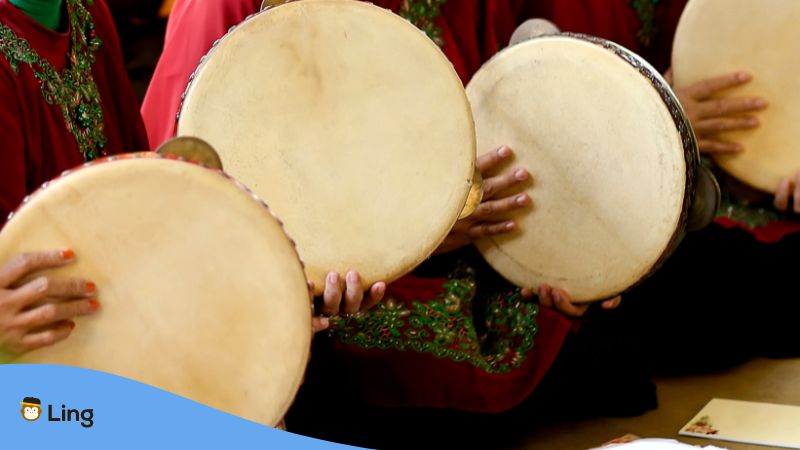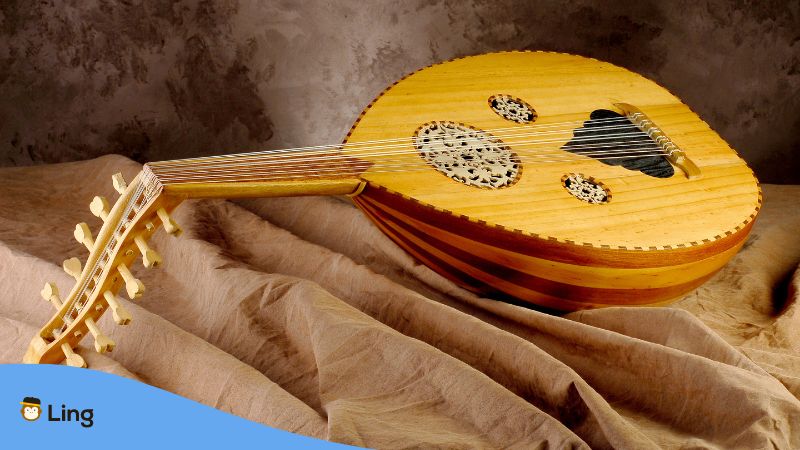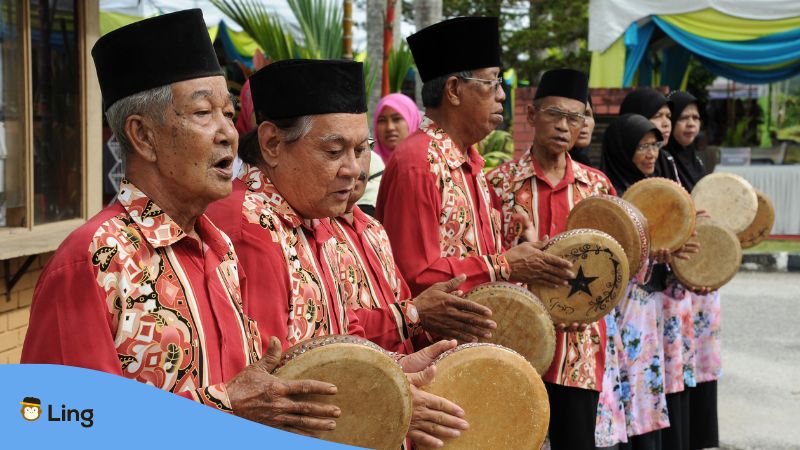Have you ever been captivated by Malay music’s enchanting melodies and rhythmic beats?
Good, because today, we’re about to dive into the mesmerizing world of instruments in Malay music!
But wait a minute – do you know what makes these instruments so unique and captivating?
Why do they hold such an important place in the cultural fabric of Malaysia? Well, you’re going to find out!
In this article, we’ll explore the various instruments that make Malay music so distinctive and fascinating.
From percussion instruments to wind instruments, we’ve got it all covered.
And trust us, by the end, you’ll have a newfound appreciation for the rich and diverse world of Malay instruments. Let’s get started!
The Three Main Categories Of Malay Instruments
We’re kicking off with the three main categories of Malay instruments: percussion, string, and wind. Here’s a glimpse into the vibrant sounds of Malay music:

Percussion Instruments
Percussion instruments are the rhythmic backbone of Malay music, making our hearts race and our feet tap. Let’s take a look:
Drums: The Heartbeat Of Malay Music
- Rebana: You know the Rebana, right? That frame drum that’s often used in ceremonial music. It comes in various sizes, and it’s played using the hands. Its deeply resonant sound makes it perfect for accompanying religious or cultural events.
- Gendang: The Gendang is another crucial player in the Malay drum world. It’s a double-headed drum that you’ll frequently find in ensembles. It can produce diverse tones, setting the mood for any occasion, from somber to lively.
Kompang: Time To Celebrate!
Have you ever heard of the Kompang? It’s a handheld frame drum typically played in groups during “perkahwinan” (weddings) and other celebrations.
Its energetic beats create a jubilant atmosphere as people gather to celebrate love and unity.
Gong And Other Metallic Percussion Instruments: A Dash Of Brilliance
- Caklempong: Malay music also features metallic percussion instruments like the Caklempong. It’s a small brass or bronze gong that produces a bright, shimmering sound, adding a touch of brilliance to any musical ensemble.
- Bonang: The Bonang, a set of horizontally-mounted gongs, can be found in gamelan ensembles. These gongs create a rich, layered sound that adds depth and complexity to the music.

String Instruments
String instruments are essential to Malay music, creating soothing and captivating melodies. Here are some of them:
Sape
The Sape is a lute that comes from Borneo and has a unique sound quality.
It’s often used in various cultural performances, and its soothing, melodic tone captivates listeners.
Gambus
The Gambus, a cherished stringed instrument, is particularly popular in coastal regions and is often associated with traditional folk music.
Its rounded body, short neck, and typically six strings produce a rich, resonant sound that captivates listeners.
It’s an integral part of traditional Malay ensembles and serves as a rhythmic foundation for various forms of music.
This includes the ghazal and zapin, showcasing Malaysia’s cultural richness and diversity.

Wind Instruments
Wind instruments add a unique flair to Malay music and are often used to create mesmerizing melodies. Let’s have a look:
Serunai
The Serunai, a reed flute, is a traditional woodwind instrument with a unique tone that can be heard in various cultural performances.
It’s typically made from wood or buffalo horn, producing a high-pitched, nasal sound, making it easily distinguishable in a musical ensemble.
Seruling
The Seruling, a bamboo flute, is another popular wind musical instrument in Malay music.
It’s known for its versatility, and it can be played in different styles, from slow, soothing melodies to upbeat, lively tunes.
This flute is crafted from bamboo and is often used in traditional Malay music and contemporary and fusion styles, showcasing its adaptability in various musical genres.
Traditional Performances Featuring Malay Instruments
Going deeper into instruments in Malay, we’ll find their influence in various traditional performances and musical forms.
From captivating dances to enchanting theater, these instruments are crucial in enriching cultural experiences.
Let’s take a closer look at how these instruments come to life in traditional performances and some of the unique musical forms that feature them.

The Role Of Instruments In Dance, Theater, And Other Performances
When you dive into the colorful realm of Malay culture, you can’t miss how powerful musical instruments are in traditional performances.
Whether you’re witnessing a mesmerizing dance, an orchestra, or a theatrical act, the harmonious blend of instruments often elevates the experience.
Imagine the energetic beats of the kompang accompanying a spirited zapin dance.
Or the hypnotic tunes of the sape setting the mood for a shadow puppet performance.
It’s this unique instrumentation that makes the shows unforgettable.
Gamelan, Nobat, And Kompang As Examples Of Ensembles
Malaysia’s linguistic diversity plays a fascinating role in shaping the distinctive ensembles found throughout the country. Let me give you some examples:
- Gamelan: This ensemble has roots in Java, a collection of instruments woven into the fabric of Malay music, particularly in courtly traditions. It’s like a beautiful blend of sounds that takes you on a musical journey.
- Nobat: The nobat ensemble, featuring gongs and drums, symbolizes Malaysia’s royal past and resonates with the nation’s history. It’s like listening to the echoes of a glorious era.
- Kompang: And who can forget the lively kompang ensembles? Their energetic beats are an integral part of Malay festivities, getting everyone in the mood to celebrate.
Musical Forms Featuring Malay Instruments
As we explore various musical forms, you’ll see a beautiful array of Malay instruments on display. Here are some of them:
- Dikir Barat: In dikir barat, a popular form of group singing, performers use the rebana to create a captivating rhythm. It’s like having a conversation with music, and the rebana is the heartbeat that keeps everyone in sync.
- Ghazal: The soothing sounds of the gambus can be heard in the romantic melodies of ghazal music. It’s like being transported to a dreamy world where love and emotions take center stage.
- Joget: The joget dance showcases a vibrant blend of percussion and melodic instruments, including the seruling and gendang. It’s like a lively party inviting everyone to join in the fun!

Unique Playing Techniques For Each Instrument
Mastering Malay instruments requires learning a variety of playing techniques that set them apart. Let’s see how they are played:
- Sape: For instance, the sape requires a delicate plucking method. It’s like giving life to each string with every gentle touch.
- Serunai: Playing the serunai involves skillfully controlling one’s breath and using your fingers to create different pitches.
- Gendang: The gendang needs a combination of hand and finger techniques to produce a wide range of tones.
- Gambus: To play the gambus, you need to master the art of plucking and strumming its strings.
- Seruling: The seruling requires a gentle yet controlled blowing technique and finger placement to create various melodies.
- Kompang: Playing the kompang involves a combination of hand strikes and finger taps to create intricate rhythms.
Each instrument has its own set of techniques contributing to its distinct sound.
By mastering these techniques, you’ll become a skilled musician and gain a deeper appreciation for the rich cultural heritage of Malay music.
Helpful Vocabulary About Malay Instruments
Ready to expand your musical vocabulary? Let’s learn some Malay words for different instruments! Let’s look at the table below:
| English | Malay | Pronunciation |
| Drum | Gendang | gén-dahng |
| Flute | Seruling | sé-roo-ling |
| Lute | Gambus | gám-boos |
| Frame Drum | Kompang | kóm-pahng |
| Gong | Gong | gohng |
| Reed Flute | Serunai | sé-roo-nigh |
| Cymbals | Caklempong | chak-lém-pohng |
| Zither | Kacapi | kah-cháh-pee |
| Two-stringed fiddle | Rebab | réh-bab |
| Bamboo xylophone | Talempong | tá-lehm-pohng |
Now that you’ve added these Malay words for instruments to your vocabulary, you’ll be able to engage with local musicians and share your passion for traditional music.
Continue to learn the Malaysian language, and you’ll enjoy the vibrant world of Malay music and the richness of its culture!

Learn The Instruments In Malay With Ling!
We hope you enjoyed discovering the fantastic world of instruments in Malay. But don’t stop here!
You can learn more about this fascinating culture by learning the Malay language with the Ling app.
This game-like app helps you learn not just Malay but over 60 different languages in a fun and easy way.
Get closer to the culture and expand your knowledge while enjoying the learning process.
Download the Ling app from Google Play or App Store today and experience a new world of languages right at your fingertips!

































































